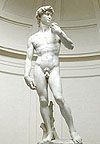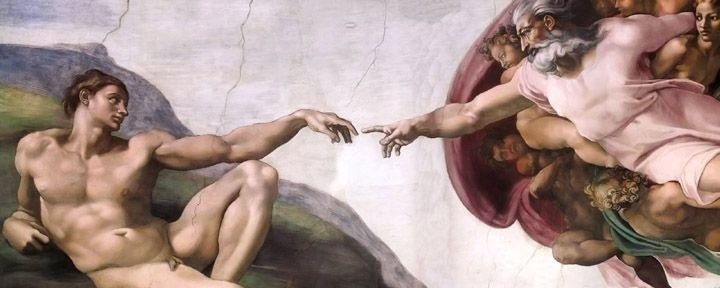| MICHELANGELO | ||
Michelangelo Free Bible Art Works In High Resolution Images. Art and artist study of Michelangelo biblical paintings.
Royalty Free |
Michelangelo di Lodovico Buonarroti Simoni 1475 – 1564 "Today I, Michel Angelo, sculptor, began the painting of the Chapel." Here we have his own written statement, dated March 10, 1508. It was set down in despair by the great "sculptor who painted." A little less than a year later, when the work on the Sistine Chapel was well under way, he protested again, "This is not my profession. I am uselessly wasting my time." Michelangelo, recognized as the greatest sculptor of the world, had been recalled to Rome by Pope Julius II and commanded to decorate the ceiling of the Sistine Chapel. He pleaded that painting was not his trade and insisted that the task should be given to his young rival Raphael. Perhaps he was still smarting under the humiliation of having been thrust out of the Vatican by a servant only a few months before. But the Pope was adamant and Michelangelo reluctantly went to work on the Chapel, learning the technique of painting as he labored. "Destiny so ruled", writes Sidney Colvin, "that the work thus thrust upon him remains his chief title to glory." Michelangelo was born in a small town outside of Florence. His nurse was the wife of a marble cutter. In later years the great artist jokingly remarked that his love of sculpture had been sucked from the breast of his foster-mother. One of his first pieces of carving was "Sleeping Cupid." It was carried to Rome and fraudulently sold to a Cardinal as an antique piece of Greek sculpture. When the Cardinal learned of the deception he was so delighted to know that a living Italian could produce work that rivaled the early Greeks that he sent for the sculptor and bestowed his favor upon him. Michelangelo began work on the Chapel with a corps of assistants, but soon he drove them away and painted out everything they had done. Not content with dispensing with their services, he tore down the scaffoldings they had erected and put up his own. Then he locked the door and for four years toiled on in sorrow and fury. At last, on All Saints' Day in 1512, he removed the scaffoldings from which the impatient Pope had threatened to have him thrown, and after lying on his back for four years to paint the ceiling, he stood on his feet once more to receive the greatest ovation ever tendered any artist. Raphael openly thanked God that it had been given to him to live in the same century with Michelangelo. The great sculptor lived to be nearly ninety, working with undimmed vision and unflagging genius up to the very end. A friend met the great man one day near the Colosseum. He was on foot making his way through the snow, aged, infirm and alone. The friend inquired where he was going. "To school", he replied, "to school, to try to learn something." From his earliest youth Michelangelo cherished all worthy things, his art first, to which he gave himself completely in spite of his father's opposition. Ordinary pleasures he held in contempt, and he worked without ceasing and denied himself every luxury. "More than this", Taine writes, "he lived like a monk, without wife or mistress, chaste in a voluptuous court, knowing but one love, and that austere and Platonic, for one woman as proud and as noble as himself. At evening, after the labor of the day, he wrote sonnets in her praise, and knelt in spirit before her, as did Dante at the feet of Beatrice, praying to her to sustain his weaknesses and keep him in the 'right path.' He bowed his soul before her as before an angel of virtue. She died before him, and for a long time he remained 'downstricken, as if deranged.' Several years later his heart still cherished a great grief – the regret that he had not, at her deathbed, kissed her brow or cheek instead of her hand." Navigation and Searching – Terms of Use – Contact Us |

